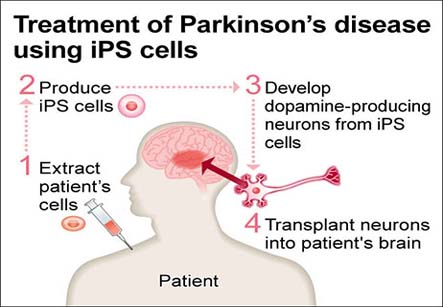Parkinson’s
Introduction
Parkinson’s disease is a degenerative disease of the brain. It mainly occurs due to a slow loss of a specific type of nerve cell, located in an area of the brain called the substantia nigra. These nerves are responsible for the production of a natural chemical called dopamine. Lack of this chemical in the brain may lead to difficulty in movement, posture maintenance, writing and talking. At late stages it may also lead to complete immobility. There are numerous drugs that are used to treat Parkinson’s disease. These drugs mainly act by increasing the production of dopamine in brain. Many of these drugs are associated with side effects. Additionally over time most of these drugs lose their efficacy when used over a long period of time. As of now there is no cure for Parkinson’s disease.
Iranian scientists have moved to the forefront in embryonic stem cell research, according to a recent joint study by Harvard University and the Massachusetts Institute of Technology

Parkinson’s Stem Cell Therapy
Experimentally stem cell therapy has been used for Parkinson’s disease. Stem cells are primitive cells in the body that have the capacity to become any cell. In these patients they are coaxed to become and replace the damaged nerve cells of the brain. Stem cells and bone marrow cells have been used since 1968 in patients with blood cancers like leukemia, aplastic anemia, lymphomas such as Hodgkin’s disease, multiple myeloma and even in ovarian and breast cancers.
The stem cells multiply and change into the desired cells at the site of the disease.
Many of these stem cells can come from the cord blood or the blood in the umbilical cord that joins the baby to the mother in the womb. After birth the cord blood can be collected and processed to make stem cells.
Because a single, well-identified type of cell is affected in Parkinson’s disease, stem cells offer great potential for treatment. Since stem cells have the potential to become any cells they may be coaxed to become dopaminergic neurons in the brain to replace the damaged neurons. These dopaminergic neurons can readily be obtained from embryonic stem cells in the laboratory, but there are still ethical and technical hurdles to using this source.
Basically there are two methods of grafting stem cells in patients with Parkinson’s disease. In the first method the neurons are cultivated in the laboratory in vitro. These cells are they purified, standardized and quality controlled. The other method involves injection of the stem cells directly into the site of the disease. The stem cells multiply and change into the desired cells at the site of the disease.
The actual capacity and ability of the stem cells to become functional neurons is still not very clear from the few clinical studies. The stem cells may be obtained from fertilized eggs, neural stem cells from the embryonic or adult brain, or from stem cells in other tissues. Most experts agree that neural transplantation is still at an experimental stage in Parkinson’s disease and there are several hurdles before this approach should be further tested in patients.